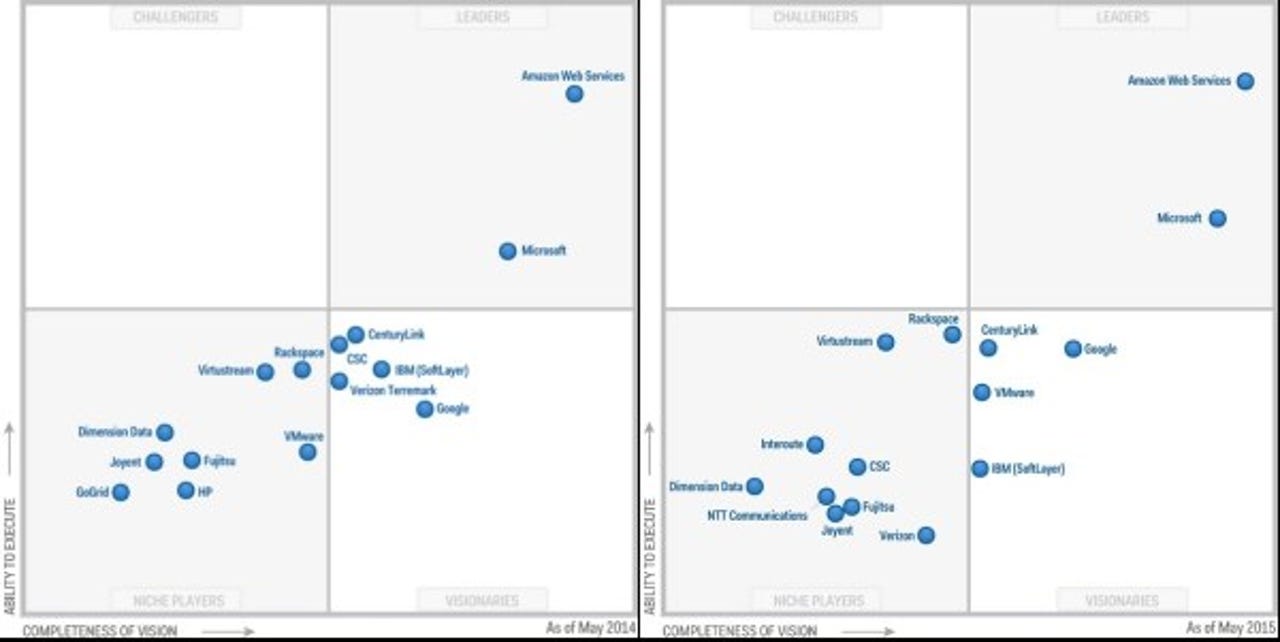Microsoft and Google rise while IBM sinks in Gartner's Magic Quadrant for cloud providers


Gartner's new cloud research - summarized in Magic Quadrant for Cloud Infrastructure as a Service, Worldwide - still gives Amazon the leading position in its "Magic Quadrant" for IaaS providers, while Microsoft has made some progress compared with last year. (See charts below.) However, compared with last year, IBM has fallen noticeably in "ability to execute", in Gartner's opinion, and been overtaken by both Google and VMware.
Gartner's Magic Quadrants plot each company's "Ability to execute" against its "Completeness of vision" and sorts them into four quadrants: Leaders, Challengers, Visionaries and Niche Players. Only Amazon and Microsoft are in the Leaders section, and there are now just four companies in the Visionaries section: Centurylink, Google, IBM (SoftLayer) and the newly-promoted VMware.
Verizon (which bought Terremark) and CSC have both been demoted from Visionaries to Niche Players - CSC was also demoted from the Leaders quadrant to Visionaries last year - while HP has been dropped altogether.
Gartner reckons that IaaS cloud infrastructures server two main purposes. Mode 1 is for "traditional IT, with an emphasis on cost reduction, safety and security". Mode 2 is for "agile IT, emphasizing developer productivity and business agility".
Amazon and Google appeal mainly to Mode 2 users, for example, while CSC, Centurylink and Fujitsu are among the suppliers that appeal mainly to Mode 1 users (outsourcing).
"Microsoft Azure appeals to both Mode 1 and Mode 2 customers, but for different reasons," says Gartner. "Mode 1 customers tend to value the ability to use Azure to extend their infrastructure-oriented Microsoft relationship and investment in Microsoft technologies, while Mode 2 customers tend to value Azure's ability to integrate with Microsoft's application development tools and technologies."
Amazon's AWS is by far the market leader for Mode 2 users. It is also "a thought leader," Gartner says: "it is extraordinarily innovative, exceptionally agile, and very responsive to the market. It has the richest array of IaaS features and PaaS-like capabilities." It also has a multi-year market lead, but is beginning to face more competition from Microsoft and Google.
Microsoft started with PaaS (Platform as a Service) but moved into IaaS in April 2013. Gartner says "Microsoft Azure is growing rapidly, and is in second place for market share, with more than twice as much cloud IaaS compute capacity in use as the aggregate total of the remaining providers in this Magic Quadrant (excluding market share leader AWS)."
However, "Microsoft's partner ecosystem is still relatively nascent" (Amazon's is very strong) and "the Azure ecosystem is very dependent on existing Microsoft relationships. Although customers do run heterogeneous environments in Azure, this lessens the appeal of Azure to non-Microsoft-centric organizations," says Gartner.
Google also offers both IaaS (Compute Engine) and PaaS (App Engine) cloud services. But Gartner says: "Although Google has significant appeal to technology-centric businesses, it is still in the rudimentary stages of learning to engage with enterprise and midmarket customers, and needs to expand its sales, solutions engineering and support capabilities." It also warns that "Google also lacks many capabilities important to businesses that want to migrate legacy workloads to the cloud."
IBM achieved some scale in the IaaS business by buying SoftLayer. However, Gartner says SoftLayer "typically sold to Mode 2 customers (specifically start-ups and gaming companies with a strong interest in bare-metal dedicated hosting). Since the acquisition, IBM has increasingly focused on acquiring Mode 1 customers, but SoftLayer better meets the needs of Mode 2 customers." Gartner also notes that "IBM's aPaaS (BlueMix) is hosted in SoftLayer data centers but the offerings are not integrated."
Further, Gartner warns that "SoftLayer is not a market share leader in cloud IaaS (based on Gartner estimates) and does not have the scale of the market leaders; customers anticipating large-scale deployments must ensure that IBM has the necessary capacity in those specific data centers, and that they can obtain that capacity in a cloud model."
VMware, owned by storage company EMC, is the market leader in virtualization and this led to its IaaS offering, now called vCloud Air. This appeals to IT departments that have already invested in VMware. However, Gartner says: "vCloud Air has limited appeal to the business managers and application development leaders who are typically the key decision makers for cloud IaaS sourcing." Worse, "the most likely champions of vCloud Air within a business ... are also often the people that the business is trying to bypass by going to cloud IaaS."
Gartner's full report on IaaS contains a massive amount of information - even the free public summary runs to around 20,000 words - and is well worth consulting for those buying cloud services. However, note that "it does not cover cloud storage providers, platform as a service (PaaS) providers, software as a service (SaaS) providers, cloud service brokerages (CSBs) or any other type of cloud service provider". Gartner has a separate report on what it calls "cloud-enabled system infrastructure (CESI)" which "may include forms of managed hosting, data center outsourcing and other IT outsourcing services".
Links
Magic Quadrant for Cloud Infrastructure as a Service, Worldwide (May 2015)
Magic Quadrant for Cloud Infrastructure as a Service (May 2014)